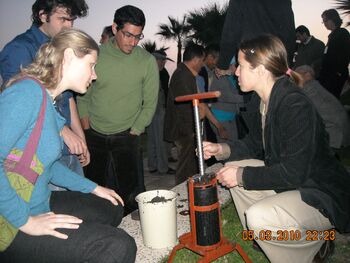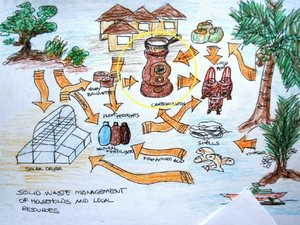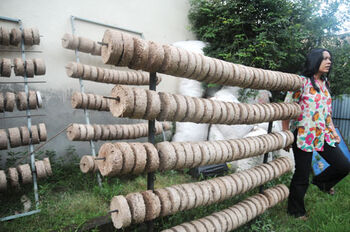Ben Hedrick (talk | contribs) mNo edit summary Tag: rte-source |
Tom Sponheim (talk | contribs) mNo edit summary Tag: sourceedit |
||
| (3 intermediate revisions by one other user not shown) | |||
| Line 1: | Line 1: | ||
{{GoogleTranslateLinks}} |
{{GoogleTranslateLinks}} |
||
| − | {{Updated| |
+ | {{Updated|2|25|16}} |
[[File:Biomass_briquettes.jpg|right|350px]] |
[[File:Biomass_briquettes.jpg|right|350px]] |
||
[[File:Briquette_press_2010.jpg|thumb|350px|Briquette press being demonstrated at [[Cyprus]] conference in 2010]] |
[[File:Briquette_press_2010.jpg|thumb|350px|Briquette press being demonstrated at [[Cyprus]] conference in 2010]] |
||
| Line 8: | Line 8: | ||
''[Excerpt from ''[http://beacononline.wordpress.com/2009/09/04/nepal-toads-eye-view-way-forward-for-nepal; The Himalayan Beacon'' website'']'', Sept. 4, 2009.]'' |
''[Excerpt from ''[http://beacononline.wordpress.com/2009/09/04/nepal-toads-eye-view-way-forward-for-nepal; The Himalayan Beacon'' website'']'', Sept. 4, 2009.]'' |
||
| ⚫ | |||
| ⚫ | |||
| ⚫ | |||
| + | =={{HeadingNews}}== |
||
| − | ==Recent news and developments== |
||
*{{NewNov15}}'''August 2015:''' The [[Mount Kenya Energy Project]]'s German organisation [[Lernen-Helfen-Leben e.V.]] has focused on the construction of gasifier/pyrolysis stoves during the past threeyears. These stoves perform very well when pellets or [[Biomass briquette]]s made from plant waste are used. In my discussions with MKICDO board members we came to the conclusion that making briquettes for sale could be a viable income-generating project for the Kiini workshop. It would also be in line with our plans to build gasifier stoves at the new institute and train promotors to market them. Mugo found a young entrepreneur who already had some experiences in setting up such projects. We met and came up with a basic outline for a medium-scale business. The briquets will be made of sawdust and coffee husks. Sawdust is readily available from carpentry workshops. The husks are a waste product at coffee dry mills and are sold very cheaply. We went to a nearby coffee cooperative and made arrangements to be given priority once we need these raw materials. |
*{{NewNov15}}'''August 2015:''' The [[Mount Kenya Energy Project]]'s German organisation [[Lernen-Helfen-Leben e.V.]] has focused on the construction of gasifier/pyrolysis stoves during the past threeyears. These stoves perform very well when pellets or [[Biomass briquette]]s made from plant waste are used. In my discussions with MKICDO board members we came to the conclusion that making briquettes for sale could be a viable income-generating project for the Kiini workshop. It would also be in line with our plans to build gasifier stoves at the new institute and train promotors to market them. Mugo found a young entrepreneur who already had some experiences in setting up such projects. We met and came up with a basic outline for a medium-scale business. The briquets will be made of sawdust and coffee husks. Sawdust is readily available from carpentry workshops. The husks are a waste product at coffee dry mills and are sold very cheaply. We went to a nearby coffee cooperative and made arrangements to be given priority once we need these raw materials. |
||
| Line 18: | Line 15: | ||
*'''December 2014:''' [[Joshua Guinto]], a specialist with Appropriate Technologies has provided an update on recovery developments in the [[Philippines]] in the wake of typhoon Haiyan. Their focus has been providing [[solar dryer]]s to dry fruits and vegetables, as wells to dry wood for bio-char and [[Biomass briquette|briquette]] production for use in [[fuel-efficient cookstove]]s. Read more at: [[Media:Guinto_Appprotech_Episode_of_Reconstruction_EAST_SAMAR_Nov_2014.pdf|The Approtech Training for Salcedo Eastern Samar]] - ''[[Joshua Guinto]], November 2014'' |
*'''December 2014:''' [[Joshua Guinto]], a specialist with Appropriate Technologies has provided an update on recovery developments in the [[Philippines]] in the wake of typhoon Haiyan. Their focus has been providing [[solar dryer]]s to dry fruits and vegetables, as wells to dry wood for bio-char and [[Biomass briquette|briquette]] production for use in [[fuel-efficient cookstove]]s. Read more at: [[Media:Guinto_Appprotech_Episode_of_Reconstruction_EAST_SAMAR_Nov_2014.pdf|The Approtech Training for Salcedo Eastern Samar]] - ''[[Joshua Guinto]], November 2014'' |
||
| + | ==Constructions plans== |
||
| + | *{{NewFeb16}}[[Media:Easy_BioPress_Micro_Compound_Lever_Press_02-16.pdf|Easy BioPress Micro Compound Lever Press]] |
||
| + | **[http://leehite.org/ewb_project.htm More information] |
||
| + | ==Variations== |
||
| ⚫ | |||
| ⚫ | |||
| ⚫ | |||
| + | {{clr}} |
||
==Resources== |
==Resources== |
||
===Reports=== |
===Reports=== |
||
| Line 43: | Line 48: | ||
{{InterwikiLink|Briquettes de biomasse}} |
{{InterwikiLink|Briquettes de biomasse}} |
||
| − | [[Category: |
+ | [[Category:Biomass briquettes]] |
Revision as of 18:26, 6 March 2016
|
Last edited: 25 February 2016
|

Briquette press being demonstrated at Cyprus conference in 2010
Collect any type of waste from you home or office including paper, cardboard boxes, saw dust, scrap wood, rice husk, fruit wastes, grass, leaves, kitchen wastes, agriculture and forest residues or industrial wastes. Shred ’em, cut ’em, soak ’em and hammer ’em and what you get is a pulp. A stinking good chunk of pulp. Now press the pulp, dry it for two to three days and what you have is your briquette, all ready to burn in a range of stoves ranging from mud stove with one burner to rocket stove and room chimneys. It is energy efficient, cost-effective, manages waste and moreover an inexpensive alternate source of energy that can fuel simple households to business houses.
A kilo of briquettes costs Rs. 16 (20 cents US) and a kg and half will take care of a day’s cooking for a family size of four,” Shrestha Arpan says, who just got back from training disadvantaged communities in Bajura, Humla & Jumla (Nepal) about this indigenous technology. “If we could take this technology to a larger scale, imagine what 600 tonnes of daily valley waste could be transformed into – 70 per cent of the waste could be utilized to make briquettes while the rest 30 could be used to manufacture compost.”
[Excerpt from The Himalayan Beacon website, Sept. 4, 2009.]
News
- August 2015: The Mount Kenya Energy Project's German organisation Lernen-Helfen-Leben e.V. has focused on the construction of gasifier/pyrolysis stoves during the past threeyears. These stoves perform very well when pellets or Biomass briquettes made from plant waste are used. In my discussions with MKICDO board members we came to the conclusion that making briquettes for sale could be a viable income-generating project for the Kiini workshop. It would also be in line with our plans to build gasifier stoves at the new institute and train promotors to market them. Mugo found a young entrepreneur who already had some experiences in setting up such projects. We met and came up with a basic outline for a medium-scale business. The briquets will be made of sawdust and coffee husks. Sawdust is readily available from carpentry workshops. The husks are a waste product at coffee dry mills and are sold very cheaply. We went to a nearby coffee cooperative and made arrangements to be given priority once we need these raw materials.

Diagram showing the role the solar dryer plays in helping produce dried fruits, vegetables, and briquettes for fuel-efficient cookstoves.
- December 2014: Joshua Guinto, a specialist with Appropriate Technologies has provided an update on recovery developments in the Philippines in the wake of typhoon Haiyan. Their focus has been providing solar dryers to dry fruits and vegetables, as wells to dry wood for bio-char and briquette production for use in fuel-efficient cookstoves. Read more at: The Approtech Training for Salcedo Eastern Samar - Joshua Guinto, November 2014
Constructions plans
Variations
Honeycomb biomass briquettes

Beehive briquettes and the briquettes mold (ICIMOD, 2009)
Briquettes make use of compacted agricultural wastes, including fallen dry leaves, for fuel. Beehive briquettes (a honeycomb beehive-shaped biomass briquette) are made using a hand mould. The air channels help the briquette burn more easily.
Resources
Reports
- January 2013: Solar Cooking with Integrated Systems - FOST
Audio and video
- October 2013:
- June 2010:
See also
- Foundation for Sustainable Technologies (FoST)
- El Fuego del Sol
- Rocket Stove
- Partnership for Clean Indoor Air
External links
- Open Source DIY Biomass Briquette Technology Design and Formulations
- Fuel Briquettes Put Energy in the Peoples’ Hands - Engineering for Change
- Partnership for Clean Indoor Air (PCIA) Bulletin #29 The issue focuses on the fuel side of the improved stoves equation, with an in depth discussion of charcoal and briquettes.
- Biomass Briquette Maa Kamla Santosh Biomass Fuel Industry India
- HELVETAS Swiss Intercooperation document containing information about their biomass briquette work



